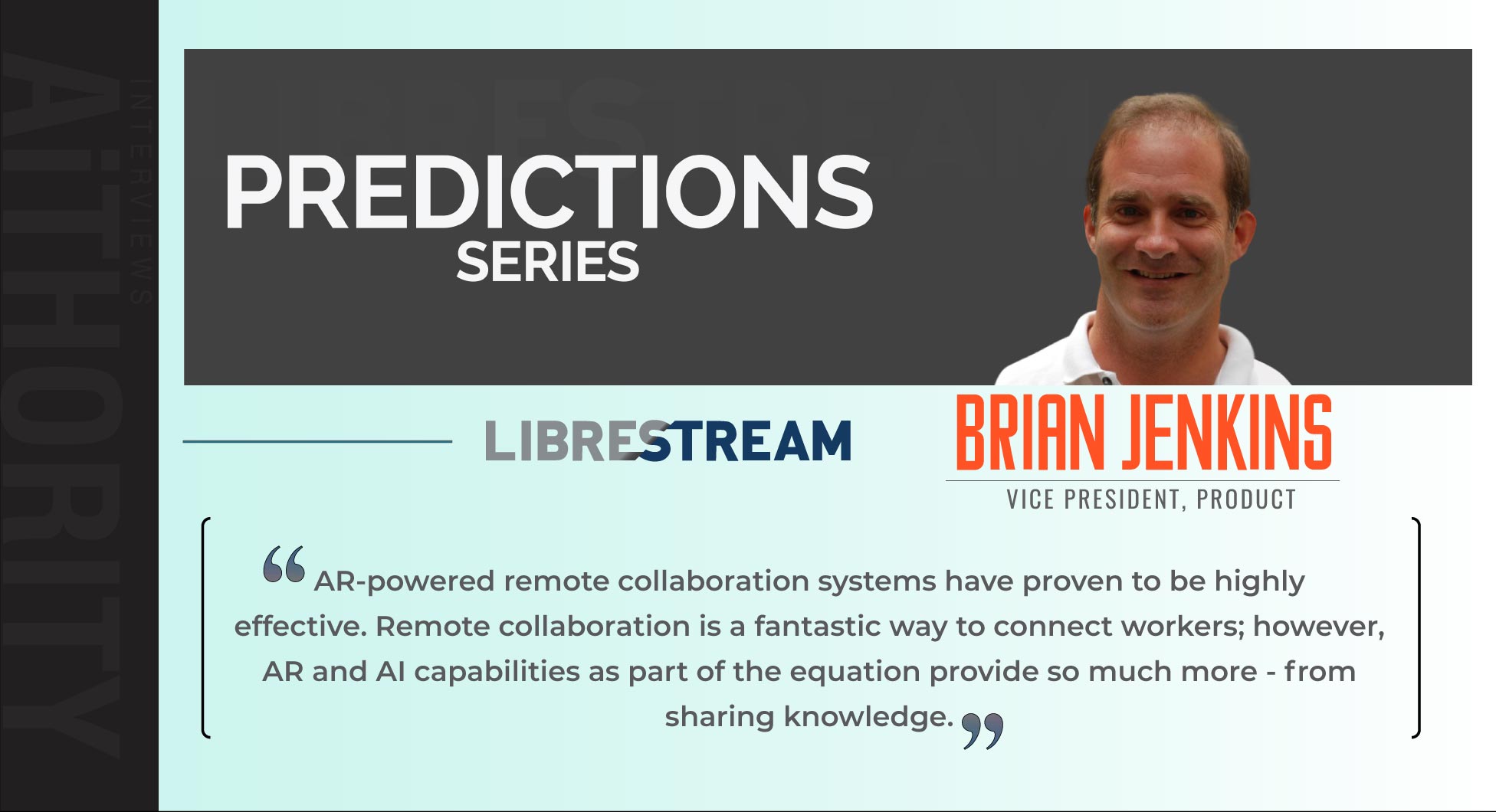Predictions Series 2022: AiThority Interview with Brian Jenkins, VP, Product at Librestream

Please tell us a little bit about your journey and what inspired you to start with Librestream.
I have been working with high-tech companies for over 30 years. I got my start with computer science from Duke University and then spent 20 years in Silicon Valley at venture-backed startups and have now spent almost 10 years in RTP.
I was drawn to Librestream for a multitude of reasons, starting with the product portfolio, which highlights the practical uses of innovative technology to solve significant business needs as well as the incredible list of customers in industrial markets that are facing macroeconomic challenges that are driving digital transformation requirements. And, of course, the extensive experience the company has working directly with organizations to help them design, develop, and deliver solutions that change how they approach their industry.
I just celebrated my one-year anniversary with Librestream, and it is great to be a part of an organization that is not only moving technology forward, but cares about how they do it and who is impacted by it. It is important for me to be a part of a company that not only is recognized as the #1-rated provider of augmented remote expert technology, but that is helping transform industrial workforces by empowering the field workers with immediate access to expertise and knowledge through the toughest environments.
Please tell us how has the role of a modern workforce transformation software changed during the pandemic. What are the expectations from these platforms today?
In general, the pandemic accelerated the need for remote collaboration and guidance to replace activities that were no longer feasible in person. When it came to the field workforce, the change was at a different scale. These workers still needed to be in the field, but their work could be accelerated by modern technology that allows them to connect with any experts wherever they are.
For example, consider the inspections that are necessary to keep food supplies safe and critical facilities running. With traditional travel being impacted through the pandemic, technologies like AR (Augmented Reality) and AI grew in adoption. The pandemic-induced new working environments required fresh solutions that digital transformation could provide. This shift has continued post-pandemic because of the benefits organizations have seen – including business continuity, cost efficiencies, time savings, enhanced productivity, and improved safety on-the-job.
The platforms today are expected to become even more efficient, especially as organizations implement innovative technologies and figure out what works and what needs to be improved.
Recommended: Predictions Series 2022: AiThority Interview with Dr. Jack Zeineh, Co-Founder and CTO at PreciseDx
How effective are AR-powered remote collaboration systems?
AR-powered remote collaboration systems have proven to be highly effective. We have seen customers increase their number of inspections threefold, which is no easy task!
Remote collaboration is a fantastic way to connect workers; however, AR and AI capabilities as part of the equation provide so much more – from sharing knowledge that otherwise could be lost, guiding workers on specific tasks with historical and institutional knowledge, supporting re-skilling and upskilling processes, etc. With teams all over the world, businesses collaborating remotely save time and resources, enabling teams to correctly use, assess, and implement technologies in real time.
What are the measurable outcomes that you have evaluated for your customers?
We have seen a lot of positive measurable outcomes across several industries. To list a few:
- Significant reductions in customer scheduling times for technical service support; from weeks (due to on-site service scheduling) to just 15 minutes
- Savings of over $30,000 USD annually in just the US alone
- Savings of up to 70% in productivity
- Complex service procedures that originally took 24 – 48 hours were performed in just 20 – 30 minutes
What are the critical factors that influence agility and effectiveness of AI in mainstream business processes?
There are multiple factors that influence agility and effectiveness of AI in mainstream business processes. The most important include identifying an application with the quickest path to value for both the workforce and organization, ensuring data – the right data – is being collected and fed to the platform, as well as focusing on providing an experience that does not place additional stress on the workforce.
For AI to be able to work within an organization, leaders need to test and experiment with different applications and their benefits. For example, if a company is struggling with providing background on specific tasks (such as when the task was last conducted, the results of latest inspections, etc.), by using Librestream they can gain the ability to automatically record and transcribe remote expert sessions, which in turn can provide the data needed for AI insights without adding any more work onto the fieldworker.
Recommended: Predictions Series 2022: AiThority Interview with CXOs at Aryaka, a Leader in SASE Solutions
How do you achieve these with AI at your organization?
At Librestream, we work closely with customers to develop the user experience and identify the processes that AI can help solve. We look for the opportunities that can deliver the most value the fastest.
In our technology, we typically see AI implementation in the form of natural language processing and computer vision. These tools, specifically in the way Librestream incorporates them, are utilized to connect field workers with experts while simultaneously translating other languages in real time, provide assets and resources they might need for the work they are doing, and automatically share further insights on the task.
What is your take on the buzzwords swirling around HR Technology now such as remote collaboration and AI-based automation?
These buzzwords have had an enormous impact in the space – remote collaboration has become a huge solution category, even more so since the pandemic forced organizations to send employees home. It is now a core part of workforce transformation along with other proven capabilities such as digitized work instructions.
Today, these technologies are more than a welcomed addition, they are a necessity. They may have begun as buzzwords, but their impact has been very noticeable, and we should expect to continue seeing their growth as they are more engrained into the day-to-day across industries.
What is the future of workforce transformation in the era of AI and automation?
The future of workforce transformation in the era of AI and automation is a continuation of the types of emerging technologies we have seen in the past few years.
A big focus for the near future is freeing up workforce capacity. With AI, workers’ cognitive load will be reduced by providing the information needed, when and where it is required. This will help resolve technological issues quicker and more efficiently, allowing those same workers to gain more abilities and provide further support.
We will see automation free up human capacity by replacing repetitive tasks – freeing up more time for the worker to focus on more important tasks and supporting industries when it comes to talent shortages and helping upskill their current talent.
Recommended: Predictions Series 2022: AiThority Interview with Peter Stone, Executive Director at Sony AI
Any advice to every business leader on how to use workforce management technology for their organizational development?
My biggest piece of advice is to get started today – begin experimenting with this technology and see how it fits best into your organization.
Workforce management technology is not new; businesses across industries are already providing digitization to their workers – whether this is in the form of replacing pen and paper with digitized process and AI enriched knowledge delivery or connecting field workers with experts across the world and utilizing automatic translation. Capture everything the worker is doing with things like photos, calls, recording, and data sensor reading. This then will fuel the AI to inform workers, keep them safe, and ramp up productivity.
Thank you, Brian! That was fun and we hope to see you back on AiThority.com soon.
[To share your insights with us, please write to sghosh@martechseries.com]
Librestream develops digital transformation technology that improves service operations within the industrial sector. Deployed globally, the Onsight augmented reality service platform empowers workers to rapidly diagnose, inspect, and manage assets in even the most difficult field environments.
The Onsight platform provides the right tool for every field environment – from the Onsight Cube, Onsight Connect remote expert guidance and Onsight Flow digital work instructions software on mobile devices, wearables or computers, to Onsight Workspace a specialized content solution for industrial teams. Built for enterprise, Onsight meets stringent security, network, and infrastructure requirements.
Designed to withstand difficult environments and provide high quality video with minimal bandwidth, the Onsight Augmented Reality Service Platform is safe, secure, and always reliable.


Comments are closed.